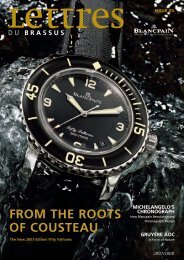THE HISTORY OF BLANCPAIN
THE HISTORY OF BLANCPAIN
THE HISTORY OF BLANCPAIN
Create successful ePaper yourself
Turn your PDF publications into a flip-book with our unique Google optimized e-Paper software.
ART DE VIVRE<br />
Mauro, an Italian community assistance<br />
worker who has been here for twenty years,<br />
has a sober – not to say resigned – commentary<br />
on this spectacle. “It’s completely surreal,<br />
as if a mouse were dying of hunger in a warehouse<br />
full of cheese! There are coffee trees all<br />
around us and here everything is in a state of<br />
neglect.” As a good Italian, Mauro dreams of<br />
getting this factory running again, in the context<br />
of fair trade with trustworthy investors.<br />
Mr. Didier, the last director of Cafema,<br />
tells how the company met its demise in<br />
1994. He mentions international competition<br />
and wear and tear on the equipment,<br />
which could not be replaced due to lack<br />
of resources. The ill-advised or ill-intentioned<br />
managers in the faraway capital of<br />
Antananarivo spent more on extravagances<br />
than on parts. He also lets drop the word<br />
“privatisation,” so dear to the high priests of<br />
liberalism who lay down their law from within<br />
the World Trade Organisation (WTO). That<br />
was all it took to bring Cafema down and<br />
reduce hundreds of families to poverty. Like<br />
so many others, Mr. Didier is out of a job.<br />
And unemployment is a very strong word in<br />
a country that has no unemployment benefits.<br />
The former director gets by as best he<br />
can, acting as an agent for several non-governmental<br />
organisations that work on the<br />
island. And the workers? They will have to<br />
manage as best they can. And the farmers?<br />
They no longer harvest coffee, no buyers<br />
want it.







